The ultimate guide to planting, growing, and caring for your Tulips!
Tulips, with their vibrant petals and elegant stature, are a beloved addition to any garden. Whether you're an experienced gardener or just starting, this comprehensive guide is your key to cultivating breathtaking tulips.
Discover the secrets to planting, growing, and caring for these iconic blooms that will turn your garden into a riot of color and beauty. Join us on this floral journey and unlock the secrets to tulip success.
How to plant Tulip bulbs?
Planting tulips is a delightful way to add vibrant bursts of color to your garden. To start, choose a location with well-draining soil and partial to full sunlight. The ideal time for planting tulip bulbs is in the fall, about 6-8 weeks before your region's first frost.
Dig a hole about three times the depth of the bulb, typically 6-8 inches deep, and ensure the pointed end of the bulb faces upwards. Add a balanced bulb fertilizer at the bottom of the hole, then place the bulb in and cover it with soil. Space bulbs about 4-6 inches apart.
Water thoroughly after planting to settle the soil. As winter approaches, mulch the area to protect the bulbs from extreme cold. Come spring, your garden will be adorned with these stunning, colorful blooms. Remember to deadhead spent flowers to encourage healthy bulb growth for the following year. Happy planting! Learn more in depth how to plant tulip bulbs effectively by following our detailed guide for perfect results every time.
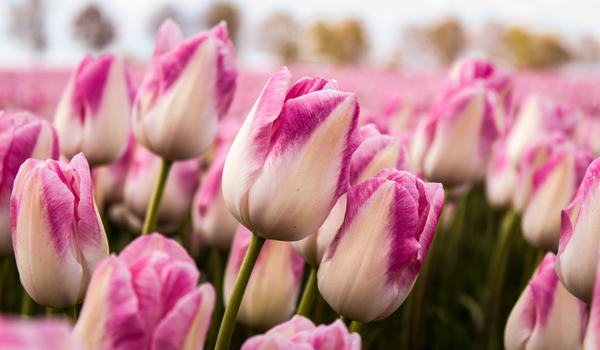
When to plant Tulips?
When it comes to planting tulips, timing is crucial for a vibrant and blooming display. The ideal time to plant tulip bulbs is in the fall, typically between late September and early December, depending on your climate zone. Planting during this period allows the bulbs to establish their root systems before the harsh winter sets in. In regions with milder winters, planting in late fall is suitable, while in colder climates, it's best to plant earlier to ensure the bulbs are well-rooted before the frost arrives. By adhering to this timeline, you'll ensure a breathtaking burst of color in your garden when spring arrives, as tulips typically bloom from early to late spring, depending on the variety. Remember to choose a well-draining location with ample sunlight to promote healthy tulip growth.
To soak or not to soak: preparing Tulip bulbs for planting
Soaking tulip bulbs before planting is generally not necessary. Tulips are hardy spring-blooming bulbs that thrive in well-draining soil. However, if you have particularly dry or sandy soil, a brief soak (about 1-2 hours) can help hydrate the bulbs before planting. This can be especially beneficial if you're planting them in a hot and arid climate. Use lukewarm water and avoid soaking them for too long, as excessive moisture can lead to rot. Additionally, soaking can slightly speed up the blooming process. But for most gardeners, planting tulip bulbs directly in prepared soil at the appropriate depth, usually 3 times the bulb's height, is sufficient for healthy growth and vibrant spring displays.
Selecting the perfect spot for planting Tulips
To ensure your tulips thrive, it's crucial to select the right planting location. These bulbs thrive in well-drained soil that receives ample sunlight. Ideally, choose a spot with at least 6 hours of direct sunlight daily. Loamy or sandy soils are perfect, as they prevent water from pooling around the bulbs, reducing the risk of rot. Avoid areas prone to waterlogging or heavy shade. When it comes to spacing, plant tulip bulbs about 4-6 inches apart to allow them room to grow. By choosing the right location, you'll encourage healthy tulip growth and a stunning springtime display.
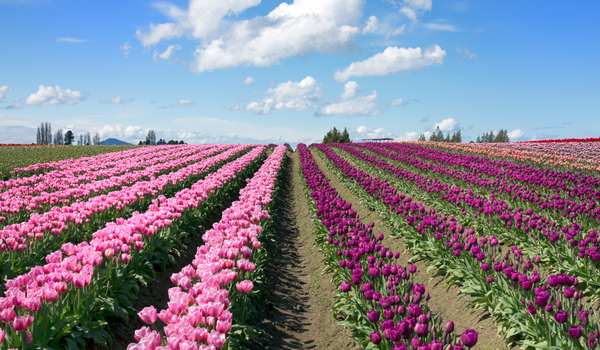
Selecting the perfect spot for planting Tulips
Tulips can thrive both in pots and in the ground, but each option comes with its own considerations. When planted in pots, tulips offer flexibility, allowing you to control soil quality, drainage, and sunlight exposure more precisely. This makes them an excellent choice for smaller gardens, balconies, or if you want to create stunning seasonal displays that can be easily rearranged. In contrast, planting tulips directly in the ground can result in more natural growth and larger blooms over time. However, you'll need to ensure proper soil preparation, drainage, and choose a suitable location with adequate sunlight. Ultimately, the choice between pots and the ground depends on your garden space, aesthetic preferences, and willingness to manage specific growing conditions.
How to grow Tulips?
To successfully grow tulips in your garden, begin by selecting a well-draining location with at least six hours of sunlight daily. Plant tulip bulbs in the fall, ideally 6-8 weeks before the first frost, at a depth of 4-6 inches, spacing them 4-6 inches apart. Ensure the soil is enriched with organic matter and is slightly acidic. Water your tulips after planting to settle the soil, and then provide only minimal watering until spring to prevent bulb rot. Apply a balanced, slow-release fertilizer in the spring as new growth appears. Remove faded flowers to prevent seed formation, but leave the foliage until it turns yellow to nourish the bulb for the next season. With these steps, you can enjoy vibrant tulip blooms year after year.
When do Tulips bloom: a quick guide
Tulips embark on a journey from bulb to blossom that typically spans several months. To coax these vibrant flowers into growth, tulip bulbs require a crucial 12-week chilling period, simulating winter conditions. This dormancy period, ideally at temperatures between 35-45°F (2-7°C), is essential for breaking their natural dormancy cycle and ensuring robust blooming. Once this chilly spell concludes and the warmth of spring arrives, you can expect tulips to stir to life and send up their tender green shoots, a sure sign that their colorful display is not far behind. In most cases, you'll witness those beautiful tulip blooms emerging within a few weeks of the arrival of spring.
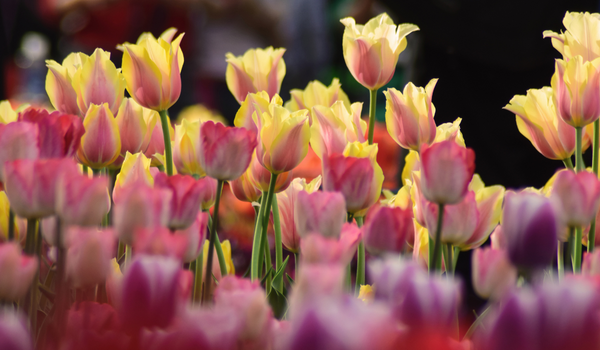
Tulip care tips: ensuring vibrant blooms
To ensure your tulips continue blooming beautifully, it's essential to follow these tips:
- Proper planting depth: plant tulip bulbs in well-drained soil at a depth of about 6-8 inches (15-20 cm) during the fall, ensuring they're spaced apart adequately.
- Sunlight: Tulips thrive in full to partial sunlight, so choose a location that receives at least 6 hours of sunlight daily.
- Watering: water your tulips consistently, keeping the soil evenly moist but not waterlogged. Avoid overhead watering to prevent diseases.
- Fertilization: use a balanced, slow-release fertilizer in early spring or before planting to provide essential nutrients.
- Deadheading: remove spent flowers promptly to redirect energy into bulb growth.
- Winter care: in colder climates, add a layer of mulch in late fall to protect bulbs from freezing temperatures.
- Pest and disease control: keep an eye out for pests like deer or squirrels, and apply appropriate repellents. Also, monitor for common tulip diseases and treat as needed.
By following these guidelines, you can enjoy a prolonged and vibrant tulip bloom in your garden.
The importance of deadheading Tulips
Deadheading Tulips is a common practice that can enhance the overall health and appearance of your tulip garden. When you deadhead tulips, you remove the spent or faded flower heads before they can go to seed. This prevents the tulip plant from expending energy on seed production and encourages it to allocate resources to bulb development instead. As a result, your tulip bulbs are likely to grow larger and produce more vibrant blooms in the following season. Deadheading also maintains the tidiness of your garden, as it eliminates unsightly withered flowers. To deadhead tulips, simply snip off the flower head just below the base, being careful not to damage the leaves or stem.
Extending Tulip blooms: what you need to know
Tulips typically bloom for about 3 to 5 weeks, depending on various factors including the Tulip variety, weather conditions, and how well they are cared for. Early blooming varieties tend to have shorter lifespans, while late blooming types can last longer. Adequate watering, proper soil drainage, and protection from extreme temperatures can extend their bloom period. Deadheading, or removing spent flowers, can also help prolong their beauty by redirecting the plant's energy from seed production to bulb development. However, once Tulips have bloomed and started to wither, they won't last much longer, and it's advisable to allow the foliage to die back naturally to nourish the bulb for the next season's growth.

Tulip multiplication: understanding offsets and propagation
Tulips primarily multiply through offsets, which are small bulbs that develop alongside the main bulb. Over time, these offsets grow into full-sized bulbs, creating more tulips. However, not all tulip varieties multiply at the same rate, and environmental factors like soil quality and sunlight can influence multiplication. To encourage tulip multiplication, allow the foliage to wither naturally after flowering, as this helps the bulbs store energy for growth. Regularly dividing and replanting tulip bulbs every few years can also promote healthy multiplication, resulting in a vibrant and expanding tulip garden
How many Tulips can you grow from one bulb?
When it comes to tulips, the general rule of thumb is that you can grow one beautiful tulip from a single bulb. Each tulip bulb contains all the nutrients and genetic material needed to produce a single stunning flower. Planting multiple tulip bulbs in close proximity allows you to create vibrant clusters or beautiful garden beds filled with colorful flowers. Keep in mind that the size and variety of the tulip bulb may influence the size and appearance of the bloom. To create a spectacular tulip display, consider planting bulbs in groups, spacing them a few inches apart, and selecting a mix of tulip varieties to extend the blooming season and add diversity to your garden.
How to care for Tulips?
To ensure your tulips thrive, follow these care tips. Plant bulbs in well-drained soil during the fall, placing them 3-4 inches deep with the pointed end up. Tulips thrive in full sun to partial shade. Water them moderately, keeping the soil consistently moist but not soggy. After blooming, deadhead the flowers by removing faded blooms but leaving the foliage until it turns yellow and withers. Fertilize with a balanced bulb fertilizer in early spring and late fall. Protect your tulips from pests like deer and rodents with netting or repellents. With proper care, your tulips will reward you with vibrant blooms year after year.
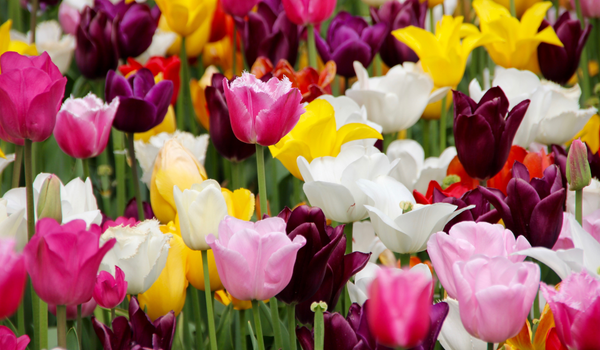
Can you leave Tulips in the ground year-round?
You can absolutely leave Tulip bulbs in the ground year-round to allow them to naturally rebloom in the following spring, as Tulips are perennials. This low-maintenance approach saves you time and effort. However, if you decide to dig them up for various reasons, such as wanting to rearrange your garden or protect them from extreme weather, make sure to store the bulbs in a cool, dry place during their dormancy period. Proper storage ensures their health and vitality, so you can replant them in the fall for another vibrant display of colorful Tulips in your garden when the next spring season arrives.
Do Tulips come back every year?
Tulips, while often associated with spring blooms, are considered perennials and can indeed come back every year. However, their return isn't indefinite. Typically, you can expect tulips to grace your garden for about 4-5 years before their blooms start to diminish. To ensure their annual return, it's essential to provide proper care. This includes allowing the foliage to wither naturally after flowering, which allows the bulbs to store energy for the next year's growth. Additionally, planting them in well-drained soil and providing adequate sunlight will help prolong their lifespan, ensuring your garden remains vibrant with tulips season after season.
Tulip pinching: a technique for lush and colorful flowers
Trimming back tulips is a crucial step in their care. Wait until the tulip blooms have faded and the petals start to wither and fall off naturally. This typically occurs in late spring to early summer, depending on your location and the specific tulip variety. It's important not to cut the foliage immediately after flowering, as the leaves continue to photosynthesize and provide energy for the bulb's future growth. Once the leaves turn yellow and begin to die back, usually six weeks after flowering, you can safely trim them back to about 1-2 inches above the soil. This allows the bulb to store nutrients for the next year's blooms, ensuring a healthy and vibrant display.
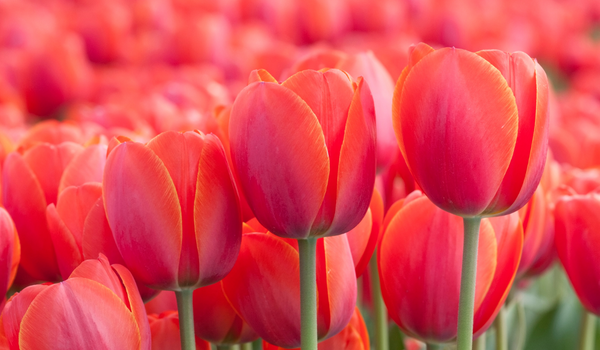
Choosing the perfect fertilizer for your Tulips
Fertilizer is not per se necessary, since Tulips already carry enough nutrients in their bulb. If you do want to add a little bit of fertilizer, use the following. The best fertilizer for Tulips is a balanced, slow-release, granular fertilizer with an N-P-K ratio of around 10-10-10 or 5-10-10. This means it contains equal or slightly higher amounts of phosphorus (P) and potassium (K) compared to nitrogen (N). Phosphorus promotes strong root development and vibrant blooms, while potassium enhances overall plant health and disease resistance. You can apply this fertilizer in early spring when the Tulips start emerging, following the recommended dosage on the package. Avoid high-nitrogen fertilizers, as they can encourage excessive foliage growth at the expense of flowers.
Looking to buy high-quality tulip bulbs for sale? Explore our wide selection of tulips on offer.
Share
